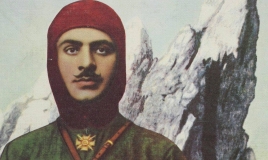Garegin Nzhdeh
Monday, November 22, 2021
Garegin Ter-Harutyunyan (1 January 1886 – 21 December 1955), was an Armenian statesman and military strategist. As a member of the Armenian Revolutionary Federation, he was involved in the national liberation struggle and revolutionary activities during the First Balkan War and World War I and became one of the key political and military leaders of the First Republic of Armenia (1918–1921).
He is widely admired as a charismatic national hero by Armenians.
In 1921, he was a key figure in the establishment of the Republic of Mountainous Armenia, an anti-Bolshevik state that became a key factor that led to the inclusion of the province of Syunik into Soviet Armenia. During World War II, he assisted the Armenian Legion of the Wehrmacht in war against USSR, hoping that if Germany succeeded in conquering the USSR, they would grant Armenia independence.
Garegin Ter-Harutyunyan was born on 1 January 1886 in the village of Kznut, Nakhchivan. He was the youngest of four children born to a local village priest. He lost his father, Ter Yeghishe, early into his childhood. Nzhdeh attended a Russian school in Nakhchivan City and continued his education at a gymnasium in Tiflis.
Shortly after, he moved to St. Petersburg to continue his education at a local university. After two years of studying at the Faculty of Law, he left St. Petersburg University and returned to the Caucasus in order to participate in the Armenian national movements against the Ottoman Empire. In 1906, Nzhdeh moved to Bulgaria, where he completed his education at the Dmitry Nikolov Military College of Sofia and in 1907 received a commission in the army with the rank of lieutenant.
In 1947 Nzhdeh proposed an initiative to the Soviet government. It would call for the foundation of a pan-Armenian military and political organization in the Armenian diaspora for the seizure of once-Armenian populated provinces of former Ottoman Empire from Turkish control and its unification with Soviet Armenia. Despite the reputed interest of the Communist leadership to this initiative, the proposal was eventually refused.
Between 1948 and 1952 Nzhdeh was kept in Vladimir Prison, then until the summer of 1953 in a secret prison in Yerevan. According to his prison fellow Hovhannes Devedjian, Nzhdeh's transfer to Yerevan prison was related to an attempt to mediate between the Dashnaks and the Soviet leaders to create a collaborative atmosphere between the two sides. After long negotiations with the state security service of Soviet Armenia, Nzhdeh and Devejian prepared a letter in Yerevan prison (1953) addressed to the ARF leader Simon Vratsian, calling him for co-operation with the Soviets regarding the issue of the Armenian struggle against Turkey. However, the communist leaders in Moscow refused to send the letter and it only remained a latent document.
After receiving a telegram from the Soviet authorities, announcing his death, Nzhdeh's brother Levon left Yerevan for Vladimir to take care of his burial service. He received Nzhdeh's watch and clothing but was not allowed to take his personal writings, which would only be published in Yerevan several years later. The authorities also did not allow the transfer of his body to Armenia. Levon Ter-Harutiunian conducted Nzhdeh's burial in Vladimir and wrote on his tombstone, in Russian, "Ter-Harutiunian Garegin Eghishevich (1886–1955)."
On 31 August 1983, Nzhdeh's remains were secretly transferred from Vladimir to rest in Soviet Armenia. The process was fulfilled through the efforts of Pavel Ananyan, the husband of Nzhdeh's granddaughter, with the help of linguistics professor Varag Arakelyan and others, including Gurgen Armaghanyan, Garegin Mkhitaryan, Artsakh Buniatyan, and Zhora Barseghyan. On 7 October 1983, the right hand of Nzhdeh's body was placed on the slopes of Mount Khustup near Kozni fountain, as Nzhdeh had once expressed the wish "when you find me killed, bury my body at the top of Khustup to let me clearly view Kapan, Gndevaz, Goghtan and Geghvadzor...".
According to the participants at the funeral, the rest of Nzhdeh's body was kept in the cellar of Varag Arakelyan's house in the village of Kotayk until 9 May 1987, when it was secretly transferred to Vayots Dzor and buried in the churchyard of the 14th-century Spitakavor Surb Astvatsatsin Church near Yeghegnadzor. Nzhdeh's gravestone was erected through the efforts of Paruyr Hayrikyan and Movses Gorgisyan on 17 June 1989, a day that later turned into an annual pilgrimage day to the monastery's graveyard.
Decades after his death, on 30 March 1992, Nzhdeh was rehabilitated by the supreme court of the newly independent Republic of Armenia.
On 26 April 2005 during the celebration of the 84th anniversary of the Republic of Mountainous Armenia, parts of Nzhdeh's body were taken from the Spitakavor Church to Khustup. Thus, Nzhdeh was reburied for the third time, finally to rest on the slopes of Mount Khustup near Nzhdeh's memorial in Kapan.
In March 2010, Nzhdeh was selected as the "National pride and the most outstanding figure" of Armenians throughout the history by the voters of "We are Armenians" TV project launched by "Hay TV" and broadcast as well by the Public Television of Armenia (H1).
In Yerevan, a public square and metro station are named after Nzhdeh.
Nzhdeh, Armenia, a village in the Syunik Province of Armenia, is named after Nzhdeh.





